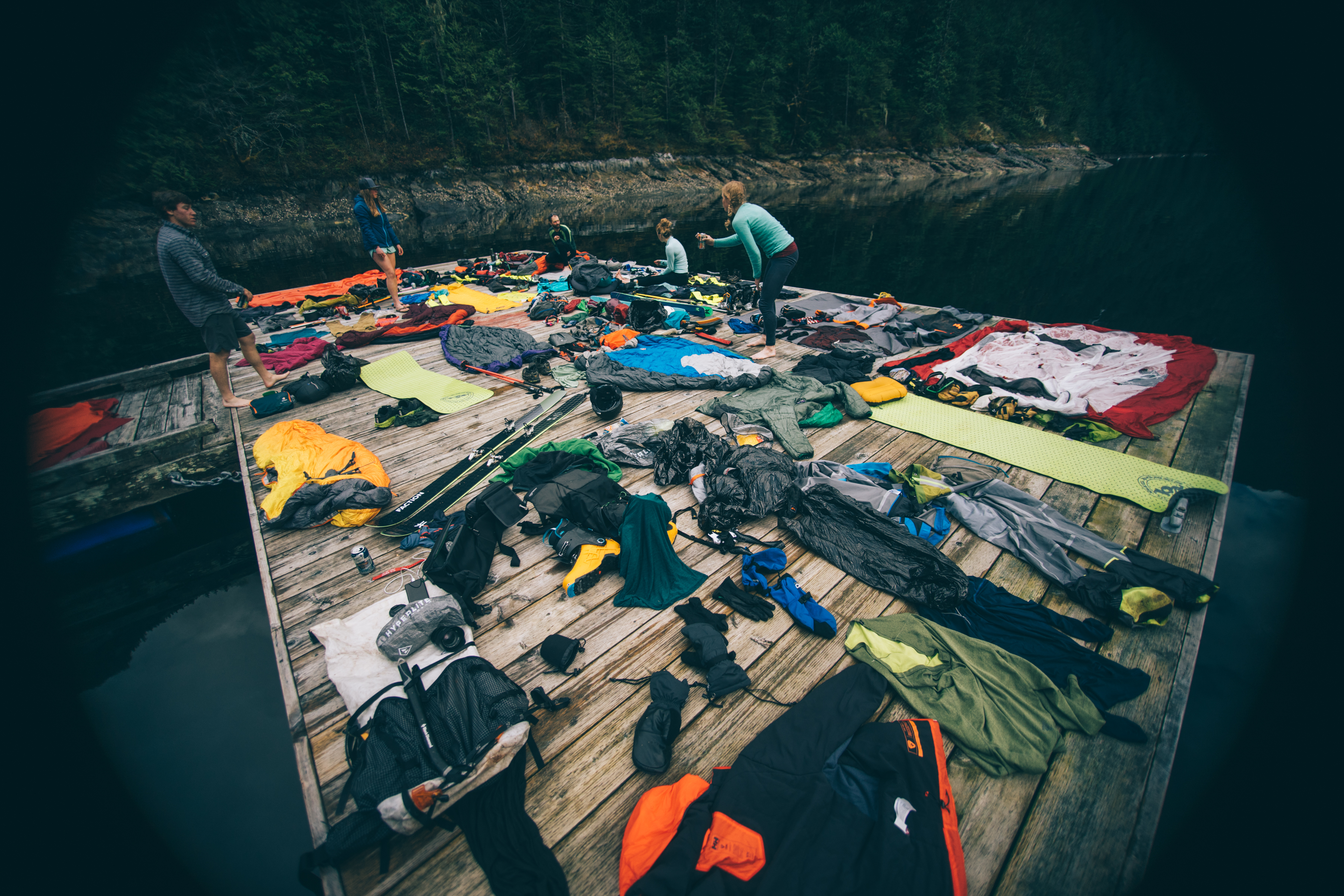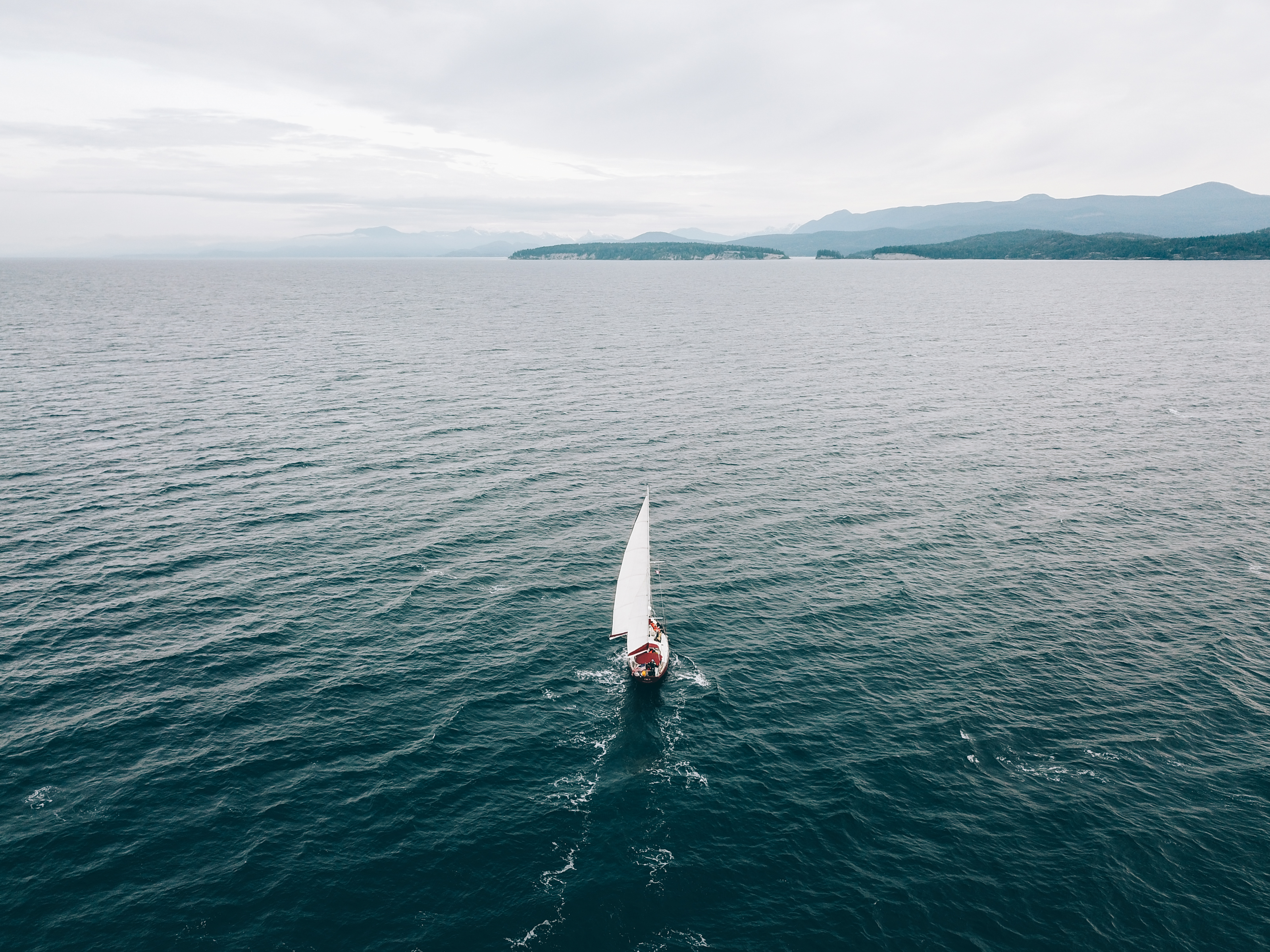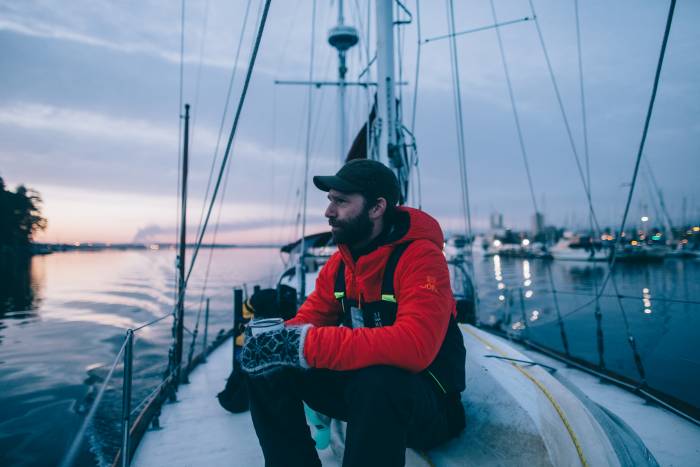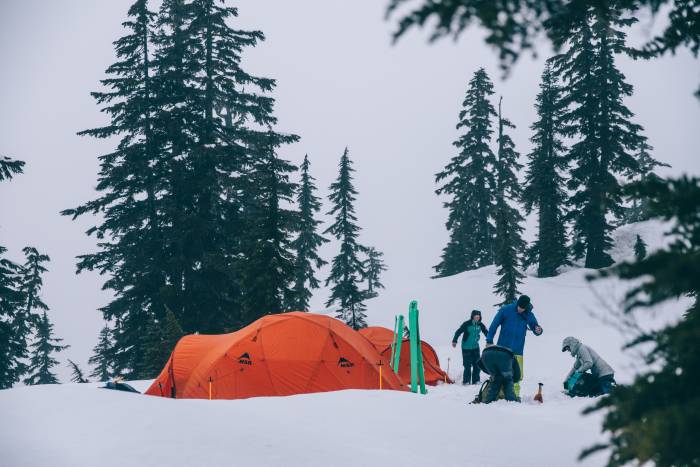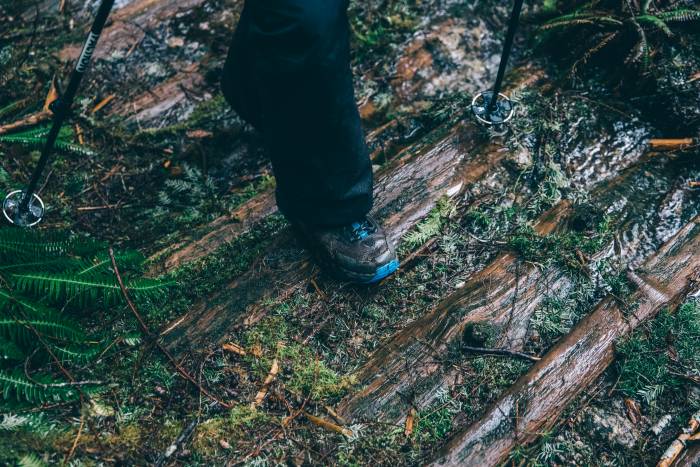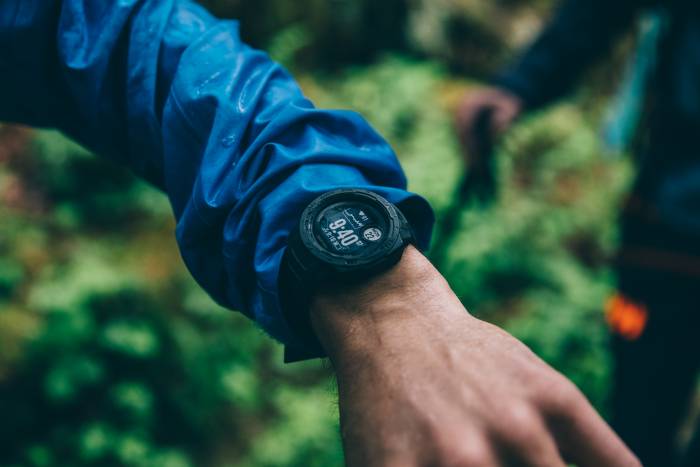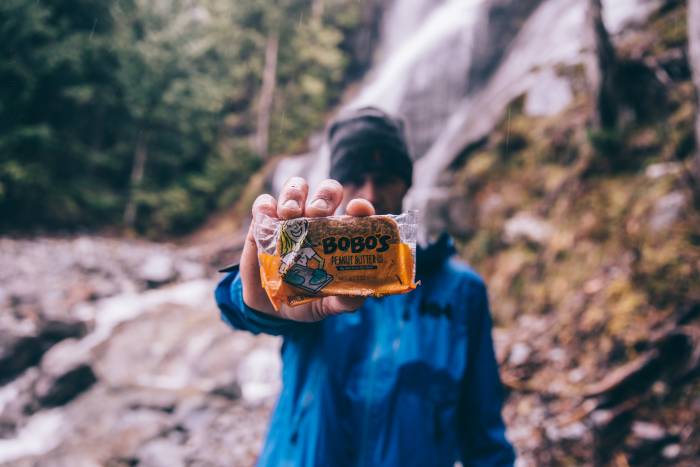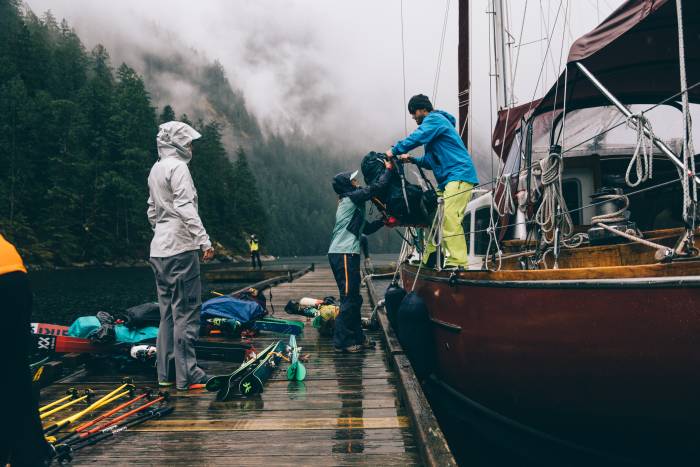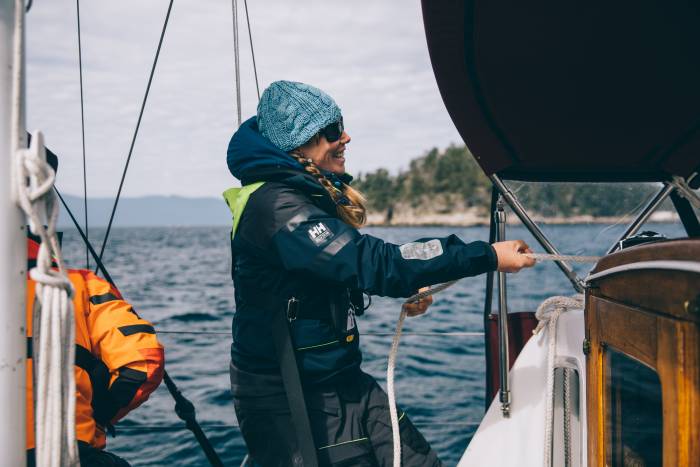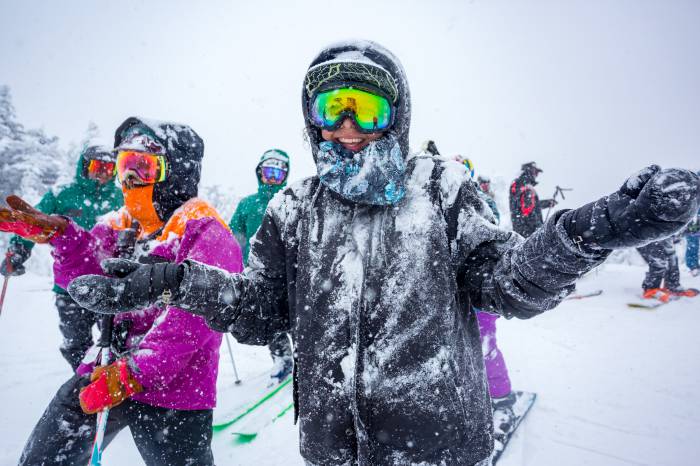After returning from an 8-day adventure along the Sunshine Coast, our writer shares the key pieces of gear that he used to sail to remote backcountry ski objectives in British Columbia.
It was 1:34 p.m. We’d been hiking for 5 hours. Still, we hadn’t seen a trace of snow, marching uphill at a glacial pace in heavy rain. The trail was poorly marked, covered with downed trees and slick from loose mud on steep granite. Not ideal for hiking, let alone hiking with skis strapped to your pack. I had hoped we’d be there already. I started to second guess our late start from the boat and a few miscues along the way. But there was nothing to do but crack a joke and keep moving upward.
Our group of eight was on a sail-to-ski trip in British Columbia, scouting for new ski lines along the coast. A few days earlier we had squeezed onto Captain Ben’s 44-foot schooner, True, and set sail north, crossing the international border. We sailed the Strait of Georgia, then wound through the web of inlets on the Sunshine Coast. It had taken us a few hours of real-life Tetris to load all of the skis, camping gear, food, and personal duffels, but we eventually found a spot for everything.
Sail-to-Ski in British Columbia
The idea for the sail-to-ski trip was straightforward enough. Starting on Bainbridge Island, Washington, we’d sail north for 3 days, covering 200 nautical miles to Princess Louisa Inlet. From there we’d load skis on our backs and begin the arduous hike uphill, through the dense, temperate rainforest. Above the treeline, we’d reach a series of glaciated peaks that appeared perfect for skiing, at least on topo maps. If all went well, we’d set up a winter camp and ski tour for a couple of days, getting first tracks on dozens of new lines. To test the theory, we had to try for ourselves.
Fifteen minutes later we saw our first few patches of snow, and soon we were skinning uphill. It felt great to finally have skis on our feet, but we weren’t fully out of dodge yet. The skin track crossed a few avalanche paths that looked to be loading, forcing us to move carefully. Safely crossed, we made our way up to the ridge and were setting up base camp by late afternoon. We spent the evening making a hearty dinner, scoping ski lines for the next couple days, and trying to contain our excitement.
Getting to this point took a lot of gear — and not just willy-nilly selections from the clearance rack at REI. Sailing offshore is dangerous and unpredictable, hiking in the pouring rain with temps in the mid-30s can be unbearably cold, and skiing on new terrain is never what you expect. Finding gear that would work for all three was our challenge for this trip. Here’s what I brought along.
Outerwear: Helly Hansen
The Norwegian apparel brand is best known for two things, bombproof ski and sailing gear, making them a natural fit for this adventure. While sailing, I wore a Skagen Jacket and bibs, keeping me warm in high winds and an occasional splash from an errant wave. While hiking, I switched to a lightweight Verglas 3L Shell and Sogn bibs on top of an Odin Stretch Puffy and wool baselayers. This combo breathed well while keeping me warm in admittedly miserable weather. We spent a large part of the day crawling under logs, squeezing between trees, and fighting through the brush. And through all of this, both of my shells held up admirably well.
Skis and Bindings: Faction and Dynafit
While we hoped for dreamy spring corn conditions, we knew that anything from wind slap to mashed potatoes to an ice rink was possible. Therefore, I selected a versatile ski with an average underfoot width that’s stiff enough to manage crud and light enough to hike 5,000 feet uphill: the Faction Prime 2.0. I mounted lightweight Dynafit Speed Turn 2.0 bindings on them, cutting all the weight I could. The combo worked great, and although I’m past the days of believing in a one-quiver setup, I do think this one is very adaptable.
Tents and Stoves: MSR
When winter camping, I prefer to bring larger tents; for example, I often recommend a three-person for two people. This allows sufficient space for wet gear and has more comfortable sleeping conditions. On this trip, we took shelter in the MSR Stormking, a five-person expedition tent with ample room in the vestibule to cook and a burly fly that can handle high winds. We also brought three stoves, two MSR WindBurner Systems and an MSR Reactor, great for boiling water quickly in the morning.
Boots: HOKA ONE ONE
Marching up a steep and slick mountain in ski boots was a nonstarter, so I brought along a lightweight and waterproof pair of HOKA Kaha hiking boots and was impressed. Leveraging the grip technologies the brand learned through developing trail-running shoes, these boots kept me safe and stable on wet roots, steep granite, and precarious steps on large logs.
Watch: Garmin
With so many variables out of our control, I wanted to do what I could to keep us reasonably paced as we climbed and skied around the Sun Peak Cirque. To do so, I used the Garmin Instinct, a durable watch that excels off the grid. It offers altitude, GPS tracking, and superlong battery life. It’s also fully waterproof, making it great for our wet adventure.
Food: Good To-Go Meals and Bobo’s Oat Bars
While on the sailboat, we ate relatively normal meals, from egg breakfasts to delicious stew dinners. On the mountain, we wouldn’t have this luxury and instead brought a mix of Good To-Go dehydrated meals. Made from real ingredients and quite filling, they were perfect for our group, helping to keep us moving. We brought a variety of snacks with us, with my favorite being Bobo’s all-natural oat bars. Tasty, simple, and healthy, I take them on almost all of my adventures.
Pack: Osprey
Last but not least, I stuffed all of this gear into my go-to pack, the Osprey Atmos 50. This pack has been strapped to my back all over the country, on hikes in Glacier National Park, traverses in the North Cascades, and family vacations to the desert American Southwest. It’s a great size, carrying just enough for a multiday trip. So far, it has held up to everything I’ve thrown at it.
If You Go
If you decide to plan a similar trip, I’d recommend reaching out to Ben at Sail Bainbridge. He’s a knowledgeable captain and expert sailor who loves to teach newcomers and adventure to new places. The best weather window for a trip like this along the British Columbian coast is in April and early May depending on snowpack. Take note that nothing is guaranteed and the wind and weather will dictate a lot.
If I were to go again, Princess Louisa would be my top destination, but other places south near Squamish or north in other inlets offer similar ski possibilities as well. Much of this terrain is untouched. The biggest obstacle is getting from the water, through the rainforest, and to the snowline.
